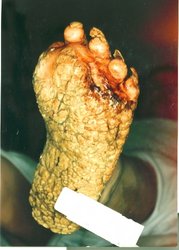TO THE EDITOR:
Leprosy is a chronic, infectious disease caused by Mycobacterium leprae. Widespread skin lesions mainly involving the extremities, abdomen and back are seen in borderline lepromatous leprosy and lepromatous leprosy. The axilla, groin, perineum and a narrow band of skin over the lumbosacral region of the back are considered to be "immune zones" because of their relative warmth (4). The palms and soles are included in immune or relatively-immune zones of leprosy by some authors because of the infrequent occurrence of lesions over these areas. We are reporting a case of borderline lepromatous leprosy that had bilateral lesions over the palms and soles mimicking keratoderma.
CASE REPORT
A twelve-year-old Hindu male presented with hyperkeratotic, fissured lesions over both the palms and soles. The patient also had bilaterally symmetrical well-defined plaques showing fine scaling over the extensor aspects of his arms, legs, thighs, chest, back, and he had a few lesions over his face resembling psoriasis. On examination, the lesions over his palms and soles were bilaterally symmetrical, thickened and fissured, extending as erythematous plaques over both of his forearms and his left foot. Touch, pain and temperature sensations were intact in most of the lesions, but small areas of sensory loss were present over his palms and soles. The ulnar and common peroneal nerves on both sides were thickened and tender. The auspitz sign was negative, and his nails were normal. Histopathological examination of the skin biopsy taken from scaly plaque over his right arm was consistent with borderline lepromatous leprosy. Slit-skin smears prepared from four sites (the earlobe, eyebrow, a lesion over his back, and a normal skin area) revealed numerous acid-fast bacilli with an average bacterial index of 4+.
He was put on multidrug therapy with dapsone, rifampin and clofazimine as recommended by WHO for multibacillary leprosy. Emollients were prescribed for the lesions on his palms and soles. After four weeks of treatment, the lesions started regressing except for palmoplantar lesions which regressed very slightly. Since the lesions over his palms and soles were atypical of Hansen's disease and not responding to the treatment significantly, a biopsy was taken from the hyperkeratotic lesion on his right palm which revealed it to be borderline lepromatous leprosy.
After twelve weeks of treatment, the lesions over his palms and soles also regressed significantly without any specific treatment of his palms and soles. He is still continuing multidrug therapy (MDT).
DISCUSSION
Hansen's disease commonly affects those parts of the body which have a relatively lower temperature. An involvement of palms and soles have been reported by many authors, such as K. Pavithran (6) and Rajendran (7), in all types of leprosy including reactional states. Indira, et al., screened 280 leprosy patients and found palmoplantar involvement in 10% of the cases. The lesions were mostly of erythematous plaque-type (5). S. K. Arora, et al., found lesions over palms and soles in only 3.6% cases of tuberculoid (TT), borderline tuberculoid (BT), and mid-borderline (BB) type of leprosy, which were of a macular type in the majority of the patients (2). Agrawal, et al., have seen nodular lesions of palms and soles in a lepromatous leprosy patient (1), while Baslas and his coworkers have reported palmar involvement in histoid leprosy (3).
The reason for the infrequent involvement of palms and soles is not clear, but it is possible that these areas may differ from other superficial areas of body in two ways. First, the epidermis over the palms and soles is thicker than other parts of body causing comparative warmth. The thick epidermis may also act as a mechanical barrier. Second, the presence of a good amount of fibro-fatty tissue insures proper insulation and high nerve-bed temperature as suggested by Sabin, et al. (8).
In our case, the lesions over his palms and soles were of plaque-type associated with fissuring, resembling palmoplantar kerotoderma. Lesions over other parts of his body resembled psoriasis. It is possible that the presence of psoriasis formed lesions of leprosy over the palms and soles gave the resemblance to keratoderma.
REFERENCES
1. AGRAWAL, U. S., BHARGAVA, P., GULATI, R. and MATHUR, N. K. Palmoplantar nodular lesions in lepromatous leprosy. Int. J. Lepr. 65 (1997) 501-502.
2. ARORA, S. K., MUKHIJA, R. D., MOHAN, L. and GIRI)HAR, M. A study of palmoplantar lesions in leprosy: a preliminary report. Indian J. Lepr. 61 (1997) 206-209.
3. BASLAS, R. G., GUPTA, M., ARORA, S. K., MAKHUA, R. D. and MISRA, R. K. Palmoplantar involvement in histoid leprosy. Indian J. Lepr. 64 (1992) 193-195.
4. COCHRANE, R. G. Signs and symptoms. In: Leprosy in Theon, and Practice. 2nd end. Cochrane, R. G. and Davey, T. F, eds. Bristol: John Wright & Sons. 1964, p. 266.
5. INDIRA, D., KOUR, I., SHARMA, A. and DAS, V. K. Palmoplantar lesions in leprosy. Indian J. Lepr. 71(2) (1999) 167-171.
6. PAVITHRAN, K. Primary involvement of palms and soles in leprosy. Report of two cases. Indian J. Lepr. 62 (1990) 123-125.
7. RAJENDRA, N. Palmoplantar lesions in paucibacillary leprosy unusual clinical expressions. Indian J. Lepr. 59 (1987) 188-190.
8. SABIN, T. D., HACKETT, E. R. and BRAND, P. W. Temperatures along the course of certain nerves often affected in lepromatous leprosy. Int. J. Lepr. 42 (1974) 38-42.
-Uma Shankar Agrawal, M.D. Archana Saxena, M.B.B.S. Ram Singh Meena, M.D. Mukesh Saini, M.B.B.S.
Department of Skin, VD and Leprosy S.M.S. Hospital, Jaipur, India
-Veena Saxena,
Department of Pathology
S.M.S. Medical College, Jaipur, India
Address for correspondence: Dr. Uma Shankar Agarwal, 397, Shankar Niwas, Shri Gopal Nagar, Near Gujar ki thadi, Gopal pura by pass, JAIPUR - 302217, INDIA
Copyright International Leprosy Association Sep 2002
Provided by ProQuest Information and Learning Company. All rights Reserved



